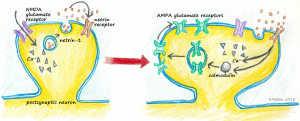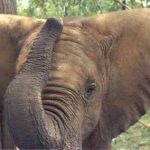0:41 | Homework!
2:03 | Netrin and memory
6:47 | Sponsored by HAPS
7:04 | Featured: Elephants and skin
23:29 | Sponsored by AAA
If you cannot see or activate the audio player click here.
Follow The A&P Professor on Twitter, Facebook, Blogger, Nuzzel, Tumblr, or Instagram!
People are so difficult. Give me an elephant any day. (Mark Shand)
1 | Homework! 1.5 minutes
Don't forget your homework assignments:
- Share this podcast with ONE other A&P colleague before the next episode arrives. Yes, I do accept late homework.
- Have questions, comments, stories, or ideas related to accommodating student needs? Pass them along for a future episode focused on this topic.
(1·833·546·6336)
podcast@theAPprofessor.org (you can attach a sound file if you like! you get double extra credit if you do!)

2 | Netrin and memory 4.5 minutes
New information about how memories form at synapses in the hippocampus tells us that netrin-1 is involved. (Click on the image to see details (you can use this image in your teaching, if you dare).
- Key molecule responsible for learning and memory discovered (summary of new discovery) https://my-ap.us/2zgjc5c
- Activity-Dependent Netrin-1 Secretion Drives Synaptic Insertion of GluA1-Containing AMPA Receptors in the Hippocampus: Cell Reports (full research article) https://my-ap.us/2zizHNU
- If the diagram is not visible in this view go to https://my-ap.us/netrin-art
 This diagram is licensed under a Creative Commons Attribution-NonCommercial-ShareAlike 4.0 International License.
This diagram is licensed under a Creative Commons Attribution-NonCommercial-ShareAlike 4.0 International License.

3 | Sponsored by HAPS 0.5 minutes
The Human Anatomy & Physiology Society (HAPS) is a sponsor of this podcast. Did you know there's a reduced "early bird" registration rate for the annual HAPS confercnce in Portland OR next May? Check it out. You can help appreciate their support by clicking the link below and checking out the many resources and benefits found there.
Anatomy & Physiology Society | theAPprofessor.org/haps

4 | Elephants and skin 16.5 minutes
Kevin's experience in zoos, circuses, and on safari in Africa form the basis of some elephant stories he tells in his A&P courses to emphasize some concepts of the integumentary system. In this episode, he shares some elephant research updates, then goes into how elephant skin can help us better understand the thermoregulatory function of human skin. The images show Kevin (on ground in dark suit) and his elephant friend Flora, the retired namesake of Circus Flora. The anterior and posterior sides of Flora's ears pictured are referred to in Kevin' stories (you may use these images in your teaching with attribution).
- Image of the Day: Swish Swish | Animals’ tails swat away insects using both wind and whack. (video and animation of the "double pendulum" pattern of elephant tails) https://my-ap.us/2zgjuZQ
- Mammals repel mosquitoes with their tails (journal article about elephant tails repeling mosquitos) https://my-ap.us/2zgkAVs
- Discerning Elephants | Elephants are able to tell human voices apart based on cues for age, sex, and ethnic group. (summary of research) https://my-ap.us/2zeeRzk
- Elephants can determine ethnicity, gender, and age from acoustic cues in human voices (journal article with full details of the research) https://my-ap.us/2zhwIoY
- Elephants Revived a “Zombie” Gene that May Fend Off Cancer (summary of research about gene that may protect elephants from cancer) https://my-ap.us/2zodgar
- A Zombie LIF Gene in Elephants Is Upregulated by TP53 to Induce Apoptosis in Response to DNA Damage (research article about cancer-protective gene in elephants) https://my-ap.us/2zi2qT5
- Why Elephants Don’t Shed Their Skin | The cracks in African elephants’ skin help them keep cool and stay healthy. A new explanation for how those cracks form could offer insights into treating a human skin disease. (brief summary article) https://my-ap.us/2zgIuQC
- Locally-curved geometry generates bending cracks in the African elephant skin (full research article which includes some cool histology images) https://my-ap.us/2zetSBl
- Elephant skin (general comments and photos from the Elephant Encyclopedia) https://my-ap.us/2zgl4ee
- Elephant foot and foot care (article from the Elephant Encyclopedia has photos of the "wedge" structure of an elephant foot and how foot care is done) https://my-ap.us/2zfy5Vj
- If the photos are not visible in this view:
- Anterior elephant ear https://my-ap.us/eleph-ear-front
- Posterior elephant ear https://my-ap.us/eleph-ear-back
- Kevin & Flora at the circus https://my-ap.us/kp-flora-circus
 These photos are licensed under a Creative Commons Attribution-NonCommercial-ShareAlike 4.0 International License.
These photos are licensed under a Creative Commons Attribution-NonCommercial-ShareAlike 4.0 International License.
5 | Sponsored by AAA 0.5 minute
The searchable transcript for this episode, as well as the captioned audiogram of this episode, are sponsored by The American Association of Anatomists (AAA) at anatomy.org

If the hyperlinks here are not active, go to TAPPradio.org to find the episode page.
- More details at the episode page.
- Transcript available at the script page.
- Listen to any episode on your Alexa device.
- Join The A&P Professor social network:
- Blog
- Twitter @theAPprofessor
- Facebook theAPprofessor
- Instagram theAPprofessor
- YouTube
Amazon referrals help defray podcasting expenses.
Transcript and captions for this episode
are supported by the
American Association of Anatomists.
The Human Anatomy & Physiology Societyalso provides support for this podcast.
(Clicking on sponsor links helps let them know you appreciate their support of this podcast!)
Transcript and captions for this episode
are supported by the
American Association of Anatomists.
The Human Anatomy & Physiology Societyalso provides support for this podcast.
(Clicking on sponsor links helps let them know you appreciate their support of this podcast!)
Click here to listen to this episode—or access the detailed notes and transcript.




No comments:
Post a Comment